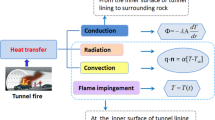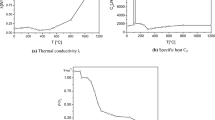Abstract
Safety assessment of tunnel lining after fire is a compulsory work and should be performed based on thermo-mechanical analysis. In this paper, a theoretical method is presented to investigate the thermo-mechanical behaviours of tunnel lining during fire development. The RABT curve is considered in this model, which includes three stages, i.e. temperature rising, temperature holding and cooling. By employing the Laplace transform and series solving method for ordinary differential equations, solutions for the time-dependent temperature and thermo-mechanical stresses are obtained. The unsteady temperature and stress distributions of the tunnel lining are discussed. Based on the limit state analysis, the fire-induced damage of tunnel lining is evaluated. All of the results are presented and discussed in detail.
Similar content being viewed by others
Abbreviations
- r, \(\uptheta \) :
-
Cylindrical coordinates
- R :
-
Dimensionless radius
- \(r_{a}\), \(r_{b}\) :
-
Inner and outer radii
- \({{R}}_{a}\), \({{R}}_{\mathrm{b}}\) :
-
Dimensionless inner and outer radii
- \(h_{2}\) :
-
Heat transfer coefficient on the outer surface
- \(\hbox {H}_{2}\) :
-
Dimensionless heat transfer coefficient on the outer surface
- T :
-
Temperature
- \(\Theta \) :
-
Dimensionless temperature
- \(\Theta _{a}\) :
-
Dimensionless maximum temperature of fire
- t :
-
Time
- \(\tau \) :
-
Dimensionless time
- \(\tau _{1}\), \(\tau _{2}\), \(\tau _{3}\) :
-
Dimensionless time points at the end of the rising, holding and cooling stage
- \({T}_{\mathrm{b}}\) :
-
Temperature of the surrounding medium
- \(\Theta _{\mathrm{b}}\) :
-
Dimensionless temperature of the surrounding medium
- \(q_{a}\), \(q_{b}\) :
-
Pressures on the inner and outer surface
- \(Q_{a}\), \(Q_{b}\) :
-
Dimensionless pressures on the inner and outer surface
- X(R,s):
-
The Laplace transformation of \(\Theta _{1}(R,\tau )\)
- s :
-
The variable of frequency domain corresponding to time domain \(\tau \)
- \(\upalpha \); \(\upkappa \); \(\uplambda \) :
-
Thermal expansion, thermal diffusion and heat conduction coefficients
- A; K; \(\Lambda \) :
-
Dimensionless thermal expansion, thermal diffusion and heat conduction coefficients
- \(\upmu \) :
-
The Poisson’s ratio
- E; \(\rho \); c;:
-
Elastic modulus, density, specific heat capacity
- Y; C :
-
Dimensionless elastic modulus, specific heat capacity
- \(\Theta (R, \tau )\) :
-
Dimensionless temperature field of tunnel lining during fire
- U(R,\(\tau \)):
-
Dimensionless displacement field
- \(\Theta _{1}(t)\) :
-
Dimensionless temperature on the inner surface for the rising stage
- \(\Theta _{2}(t)\) :
-
Dimensionless temperature on the inner surface for the holding stage
- \(\Theta _{3}(t)\) :
-
Dimensionless temperature on the inner surface for the cooling stage
- \(\Theta _{1}(R, \tau )\) :
-
Dimensionless temperature field of tunnel lining for the rising stage
- \(\Theta _{2}(R, \tau )\) :
-
Dimensionless temperature field of tunnel lining for the holding stage
- \(\Theta _{3}(R, \tau )\) :
-
Dimensionless temperature field of tunnel lining for the cooling stage
- \(\Sigma _{{r}}(R,\tau ), \Sigma _{\uptheta }(R,\tau \)):
-
Dimensionless radial and circumferential stress fields
- \(r_{{m}}\), \({E}_{{m}}\), \(\alpha _{{m}}\), \(\lambda _{{m}}\), \({T}_{{m}}\) :
-
Reference values of radius, elastic modulus, thermal expansion coefficients, thermal conductivity coefficients, temperature
- RWS curve:
-
Specified by the Rijkswaterstatt, the Netherlands Ministry of Transport and one of the most widely used fire load curves for tunnels
- RABT curve:
-
German requirement for tunnel fires
References
Khoury, G.A.: Effect of fire on concrete and concrete structures. Prog. Struct. Eng. Mater 2, 429–447 (2000)
Schrefler, B.A.; Brunello, P.; Gawin, D.; Majorana, C.E.; Pesavento, F.: Concrete at high temperature with application to tunnel fire. Comput. Mech. 29(1), 43–51 (2002)
Lai, J.X.; Wang, X.L.; Qiu, J.L.; Zhang, G.Z.; Chen, J.X.; Xie, Y.L.: A state-of-the-art review of sustainable energy based freeze proof technology for cold-region tunnels in China. Renew. Sust. Energy Rev. 82, 3554–3569 (2018)
Ma, Q.; Guo, R.; Zhao, Z.; Lin, Z.; He, K.: Mechanical properties of concrete at high temperature—a review. Constr. Build. Mater. 93, 371–383 (2015)
Fan, L.F.; Wu, Z.J.; Wan, Z.; Gao, J.W.: Experimental investigation of thermal effects on dynamic behavior of granite. Appl. Therm. Eng. 125, 94–103 (2017)
Kodur, V.K.R.; Dwaikat, M.M.S.; Dwaikat, M.B.: High-temperature properties of concrete for fire resistance modeling of structures. ACI Mater. J. 105(5), 517–527 (2008)
Ahmad, S.; Sallam, Y.S.; Al-Hawas, M.A.: Effects of key factors on compressive and tensile strengths of concrete exposed to elevated temperatures. Arab. J. Sci. Eng. 39(6), 4507–4513 (2014)
Du, S.; Zhang, Y.; Sun, Q.; Gong, W.; Geng, J.; Zhang, K.: Experimental study on color change and compression strength of concrete tunnel lining in a fire. Tunn. Undergr. Sp. Technol. 71, 106–114 (2018)
Hertz, K.D.: Limits of spalling of fire-exposed concrete. Fire Saf. J. 38(2), 103–116 (2003)
Witek, A.; Gawin, D.; Pesavento, F.; Schrefler, B.A.: Finite element analysis of various methods for protection of concrete structures against spalling during fire. Comput. Mech. 39(3), 271–292 (2007)
Zhang, H.L.; Davie, C.T.: A numerical investigation of the influence of pore pressures and thermally induced stresses for spalling of concrete exposed to elevated temperatures. Fire Saf. J. 59(59), 102–110 (2013)
Zhang, Y.; Zeiml, M.; Pichler, C.; Lackner, R.: Model-based risk assessment of concrete spalling in tunnel linings under fire loading. Eng. Struct. 77, 207–215 (2014)
Guergah, C.; Dimia, M.S.; Guenfoud, M.: Contribution to the numerical modelling of the spalling phenomenon: case of a reinforced concrete beams. Arab. J. Sci. Eng. 2, 1–13 (2017)
Poon, C.S.; Shui, Z.H.; Lam, L.: Compressive behavior of fiber reinforced high-performance concrete subjected to elevated temperatures. Cem. Concr. Res. 34(12), 2215–2222 (2004)
Habel, K.H.; Charron, J.P.; Braike, S.B.; Hooton, D.H.D.; Gauvreau, P.G.; Massicotte, B.M.: Ultra-high performance fibre reinforced concrete mix design in central. Can. J. Civ. Eng. 35(2), 217–224 (2008)
Wu, Z.J.; Fan, L.F.; Liu, Q.S.; Ma, G.W.: Micro-mechanical modeling of the macro-mechanical response and fracture behavior of rock using the numerical manifold method. Eng. Geol. 225, 49–60 (2017)
Gencel, O.: Effect of elevated temperatures on mechanical properties of high-strength concrete containing varying proportions of hematite. Fire Mater. 36, 217–230 (2012)
Ali, F.; Nadjai, A.; Choi, S.: Numerical and experimental investigation of the behavior of high strength concrete columns in fire. Eng. Struct. 32(5), 1236–1243 (2010)
Choi, E.G.; Shin, Y.S.: The structural behavior and simplified thermal analysis of normal-strength and high-strength concrete beams under fire. Eng. Struct. 33(4), 1123–1132 (2011)
Kalifa, P.; Chéné, G.; Gallé, C.: High-temperature behaviour of HPC with polypropylene fibres: from spalling to microstructure. Cem. Concr. Res. 31(10), 1487–1499 (2001)
Maluk, C.; Bisby, L.; Terrasi, G.P.: Effects of polypropylene fibre type and dose on the propensity for heat-induced concrete spalling. Eng. Struct. 141, 584–595 (2017)
Varona, F.B.; Baeza, F.J.; Bru, D.; Ivorra, S.: Influence of high temperature on the mechanical properties of hybrid fiber reinforced normal and high strength concrete. Constr. Build. Mater. 159, 73–82 (2018)
Caner, A.; Zlatanic, S.; Munfah, N.: Structural fire performance of concrete and shotcrete tunnel liners. J. Struct. Eng. 131(12), 1920–1925 (2005)
Caner, A.; Böncü, A.: Structural fire safety of circular concrete railroad tunnel linings. J. Struct. Eng. 135(9), 1081–1092 (2009)
Feist, C.; Aschaber, M.; Hofstetter, G.: Numerical simulation of the load-carrying behavior of RC tunnel structures exposed to fire. Finite Elem. Anal. Des. 45(12), 958–965 (2009)
Guo, J.; Jiang, S.; Zhang, Z.: Fire thermal stress and its damage to subsea immersed tunnel. Proc. Eng. 166, 296–306 (2016)
Capua, D.D.; Mari, A.R.: Nonlinear analysis of reinforced concrete cross-sections exposed to fire. Fire Saf. J. 42(2), 139–149 (2007)
Lai, H.P.; Wang, S.Y.; Xie, Y.L.: Experimental research on temperature field and structure performance under different lining water contents in road tunnel fire. Tunn. Undergr. Sp. Technol. 43, 327–335 (2014)
Zeiml, M.; Lackner, R.; Pesavento, F.; Schrefler, B.A.: Thermo-hydro-chemical couplings considered in safety assessment of shallow tunnels subjected to fire load. Fire Saf. J. 43(2), 83–95 (2008)
Pichler, C.; Lackner, R.; Mang, H.A.: Safety assessment of concrete tunnel linings under fire load. J. Struct. Eng. 132(6), 961–969 (2006)
Gawin, D.; Majorana, C.E.; Schrefler, B.A.: Numerical analysis of hygro-thermal behaviour and damage of concrete at high temperature. Mech. Cohes Frict. Mat. 4(1), 37–74 (2015)
Choi, S.W.; Lee, J.; Chang, S.H.: A holistic numerical approach to simulating the thermal and mechanical behavior of a tunnel lining subject to fire. Tunn. Undergr. Sp. Technol. 35(2), 122–134 (2013)
Shao, Z.S.; Wang, T.J.: Three-dimensional solutions for the stress fields in functionally graded cylindrical panel with finite length and subjected to thermal/mechanical loads. Int. J. Solids Struct. 43(13), 3856–3874 (2006)
Yan, Z.G.: A Study on Mechanical Behaviors and Fire proof Methods of Tunnel Lining Structure during and after Fire Scenarios. Ph.D. Thesis, Tongji University, Shanghai (2007)
Author information
Authors and Affiliations
Corresponding authors
Rights and permissions
About this article
Cite this article
Qiao, R., Shao, Z., Wei, W. et al. Theoretical Investigation into the Thermo-Mechanical Behaviours of Tunnel Lining During RABT Fire Development. Arab J Sci Eng 44, 4807–4818 (2019). https://doi.org/10.1007/s13369-018-3555-x
Received:
Accepted:
Published:
Issue Date:
DOI: https://doi.org/10.1007/s13369-018-3555-x




